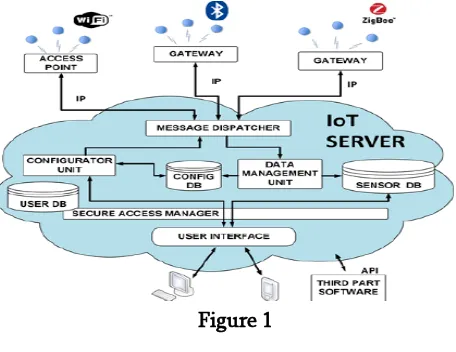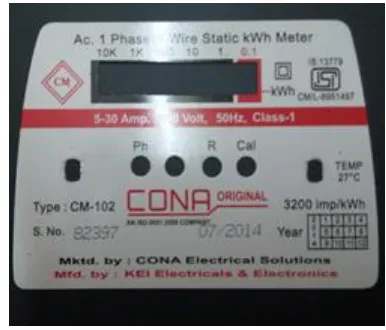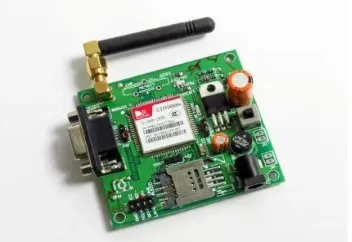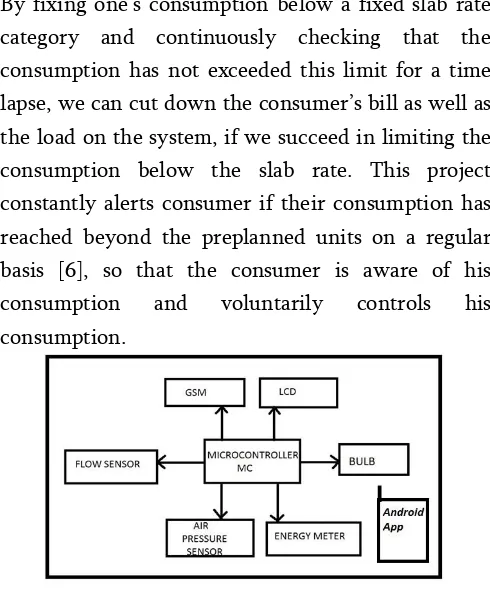CSEIT184610 | Published – 08 May 2018 | May-June 2018 [ (4 ) 6 : 46-50 ]
National Conference on Engineering Innovations and Solutions (NCEIS – 2018)
International Journal of Scientific Research in Computer Science, Engineering and Information Technology
© 2018 IJSRCSEIT | Volume 4 | Issue 6 | ISSN : 2456-3307
46
IoT based Metering and Alerting System for residential
resource consumption
Rakshanda. H. A1,Swathi. H. G1,Bhavyashree. H. L1, Akshatha. S1, Mr. B.B Neelakantappa2 1Final year BE pursuing in Computer Science & Engineering, Malnad college of Engineering, Hassan,
Karnataka, India
2B.E, Mtech, Associate Professor and TAP officer, Malnad college of Engineering, Hassan, Karnataka, India
ABSTRACT
Resources play a vital role in human life and in achieving desired economic growth. The entire fabric of developmental goals is webbed around a successful energy strategy. One of the major problem that prevails is depletion of the resources. Even though renewable resources can be replenished in a short period of time, it cannot be taken for granted. Henceforth resourceconservation promises to fill the gap between supply and demand.
Presently there is no exact way to track the daily consumption of our basic resources .
This project aims at tracking the usage of resources like water, electricity and LPG by individual houses on a per day basis.Sensed data is stored in the cloud.Along with this, user through a smartphone application will be alerted about the amount of resources they consume. It creates awareness among the users about the resource consumption by which each individual can plan and minimize resource utilization. Resource consumption of a locality can be kept in track which can be viewed by higher authority. This way of tracking resources and alerting users will lead to awareness about resource utilization and leads to global resource conservation.
I.
INTRODUCTION
INTERNET OF THINGS(IOT):
The Internet of Things (IoT) is a system of interrelated computing devices, mechanical and digital machines, objects, animals or people that are provided with unique identifiers and the ability to transfer data over a network without requiring human-to-human or human-to-computer interaction. Internet, a revolutionary invention, is always transforming into some new kind of hardware and software making it unavoidable for anyone.
The form of communication that we see now is either human-human or human-device, but the Internet of
Things (IoT) promises a great future for the internet where the type of communication is machine-machine (M2M).
IoT projects are under way that promise to improve distribution of the world’s resources to those who need them most and help us understand our planet so we can be more proactive and less reactive.
Figure 1
II.
PROBLEM STATEMENT
The per capita consumption in any country is an index of the standard of living of the people in that country. Energy demand has been rapidly increasing with raising standard of living of people. Nowadays, we are overusing the natural resources of the planet. Being aware of exhausting resources people are unable to utilize the resources efficiently because there is no measure to track it. The problem is also getting worse as population and consumption keep growing faster than technology.
The focus of our project is to track daily usage of power, water and LPG and alerting the user about his usage. The sensors used track the consumption and alert the user. All that the consumer require is a smartphone application that provides him the notification. Data of the resource consumption of a locality is also available to the administrator who can view the requirement and consumption of a locality. The higher authority or municipal procures the usage information of the locality which helps to obtain the statistical data.
The consumer who obtains his usage information can plan his usage according to his budget. Only the resources that are required will be used which to an extent reduces wastage [4] of resources.
III.
EXISTING SYSTEM
The resources we obtain are being used without any proper planning which is leading to a huge wastage. In fact, the world’s demand for power is rising faster than the demand can be met. Consequently, industries, homes, and businesses are already taking power saving measures to save money and to become more environmentally friendly. Power saving techniques seems to have a small impact to each individual, but as the price and demand for resources [5] rises, the collective power saving actions of everyone will make a significant difference. Water is an essential resource for all life on the planet. Due to the small percentage of water remaining, optimizing the fresh water we have left from natural resources has been a continuous difficulty in several locations worldwide. In the existing situation, in some parts of the country there is no system to measure water consumption. In contrast, in the metropolitan cities the water usage is billed on a monthly basis. In other cities of the country water bill is not based on the consumption rate instead it is to be paid on a yearly basis.
The next mostly used resource is LPG. Cylinders are supplied on a monthly basis and are refilled every month. The consumers are unable to track consumption which many times lead to shortage of cylinders. In all above scenarios there is no way to determine the per day usage of the resources. And there is no proper method to determine the actual requirement of the resources for a single person.
IV.
METHODS AND MATERIALS
1. SENSORS USED G ½ water flow sensor
Water flow sensor consists of a plastic valve body, a water rotor, and a hall-effect sensor. When water flows through the rotor, rotor rolls. Its speed changes with different rate of flow. The hall-effect sensor outputs the corresponding pulse Signal. The working voltage is 5v-24v.The maximum current that can flow through is 15mA (DC 5v).The external diameter of this flow sensor is 20mm and its weight is 43g.It can be stored in the temperature range of 25℃~+80℃.
Figure 2. G 1/2 Water Flow sensor
DIP Air Pressure Sensor (DIP-6, 0-40KPa):
DIP Air Pressure Sensor is used to sense the LPG pressure from which its consumption can be calculated. The specifications are as follows:
Measuring medium: Air Measuring range : 0-40kPa
Operating temperature: -40 ℃ ~ + 125 ℃ Storage temperature: -40 ℃ ~ + 150 ℃ The figure is as shown below:
Figure 3. DIP Air Pressure Sensor (DIP-6, 0-40KPa)
Energy meter:
The meter which is used for measuring the energy utilises by the electric load is known as the energy
meter. The energy is the total power consumed and utilized by a load at a particular interval of time. It is used in domestic and industrial Ac circuit for measuring the
Power consumption.
Figure 4. Energy Meter
Energy meters measure the rapid voltage and currents, calculate their product and give instantaneous power. Electricity meters are typically calibrated in billing units, the most common one being the kilowatt hour. Periodic readings of electric meters establishes billing cycles and energy used during a cycle.
2. HARDWARE
RENESAS MICROCONTROLLER BOARD
Renesas microcontroller surpasses its predecessor i.e. 8051 family of microcontrollers, with various in-built features as mentioned below:
Renesas is a 16-bit microcontroller.
Minimum instruction time can be changed from ultra-low speed (30.5us) to high speed (0.03125us).
16 to 512KB of ROM and 2 to 32KB of RAM are available depending upon the series and number of pins.
On-chip high-speed (32 MHz to 1 MHz) as well a low-speed (15 KHz) oscillator is present.
10-bit resolution A/D converter (6 to 26 channels depending upon the series) is present.
Totally 3 UART for Serial Interface is available.
Figure 5. 64 pin Renesas Microcontroller board
GSM (Global System for Mobile communications) : GSM is an open, digital cellular technology used for transmitting mobile voice and data services. GSM supports voice calls and data transfer speeds of up to 9.6 kbps, together with the transmission of SMS (Short Message Service). GSM is a cellular network, which means that cell phones connect to it by searching for cells in the immediate vicinity. GSM was intended to be a secure wireless system. It has considered the user authentication using a pre-shared key and challenge-response.
Figure 6. Global system for mobile communication (GSM)
GENERAL PACKET RADIO SERVICES (GPRS) General Packet Radio Services (GPRS) is a packet-based wireless communication service that promises data rates from 56 up to 114 Kbps and continuous connection to the Internet for mobile phone and computer users.
In order to set up a GPRS connection for wireless modem, a user must specify an APN, optionally a user name and password, and very rarely an IP address provided by the network operator.
LIQUID CRYSTAL DISPLAY
The liquid-crystal display has the distinct advantage of having a low power consumption than the LED. It is typically of the order of microwatts for the display in comparison to some order of milliwatts for LEDs. Low power consumption requirement has made it compatible with MOS integrated logic circuit. Its other advantages are its low cost, and good contrast.
Basic structure of an LCD A liquid crystal cell consists of a thin layer (about 10 u m) of a liquid crystal sandwiched between two glass sheets with transparent electrodes deposited on their inside faces.
3. SOFTWARE
The Integrated Development Environment (IDE), Cube Suite is used to generate the embedded code for the hardware mentioned. It offers the ultimate in simplicity, usability, and security for the repetitive editing, building and debugging of codes.
CubeSuite+ bundles all the basic software necessary for Renesas MCU software development in one convenient package, ready to use immediately after initial installation. CubeSuite+ is also compatible with Renesas hardware tools, such as on-chip debugging emulator E1, facilitating advanced debugging.
V.
RESULTS AND DISCUSSION
METERING AND ALERTING SYSTEM FOR RESOURCE CONSUMPTION
environment. According to David Culler, Estrin and Mani Srivastava WSNs offer an alternative approach: performing Local processing at each device and transporting the data continuously to master node [2].
By fixing one’s consumption below a fixed slab rate category and continuously checking that the consumption has not exceeded this limit for a time lapse, we can cut down the consumer’s bill as well as the load on the system, if we succeed in limiting the consumption below the slab rate. This project constantly alerts consumer if their consumption has reached beyond the preplanned units on a regular basis [6], so that the consumer is aware of his consumption and voluntarily controls his consumption.
Figure 7. Representation of metering system
In this project we use respective sensors to measure the amount of usage of water, electricity and LPG in home. Electric meter can be configured to measure electricity consumption of a load [7].This information is stored in the database [3]. Whenever the consumption will exceed the threshold, the user will be notified the amount of usage in that time span. This application is not only for common people but also for the higher authorities. The user and admin have their respective accounts. The user can only view his/her usage and the admin can view usage on locality basis.
VI.
CONCLUSION
The implementation of this project provides awareness of daily usage by which we can use the resources effectively. The penalty is imposed for
aggrandize usage of resources. By this people will be conscious about the resource usage.
Energy conservation is the only route that can get better mileage out of the available resources. These problems can be tackled with the implementation of this project by measuring and alerting the users. Since the usage of the resources is kept track of and monitored to ensure the safety of the future generation.
VII.
REFERENCES
[1] Somayya Madakam, R. Ramaswamy, Siddharth Tripathi, “Internet of Things (IoT): A Literature Review”, IT Applications Group, National Institute of Industrial Engineering (NITIE), Vihar Lake, Mumbai, India, Published Online ” May 2015”.
[2] David Culler, Deborah Estrin Mani Srivastava , “Overview of sensor networks”, Published by the IEEE Computer Society, IEEE August 2004. [3] Sujatha.D, Sushma Padmanabha, Simanta Nigam
Nayak, “Smart Liquified petroleum gas system”, International Journal of Engineering Research and Science, [vol-2, Issue5, May 2016].
[4] Cheng-Li Cheng,“Study of inter-relationship between water use and energy conservation for a building”, Received 5 May 2001.
[5] Er.Harpreet Kaur, Ms Kamaldeep Kaur,“Energy conservation: An Effective way of energy utilization”, Volume 2 Issue 5, Received May 2012.
[6] Kirori Mindo,Moses M Thiga, Simon M Karume ,“A scalable ZigBee WPAN for water flow telemetry” ,IST-Africa Week Conference (IST-Africa), 09 November 2017.
[7] Thomas D. Pitite, Richard M.Huff, “Systems and methods for providing remote monitoring of electricity consumption for an electric meter”, 24 April 2007.



